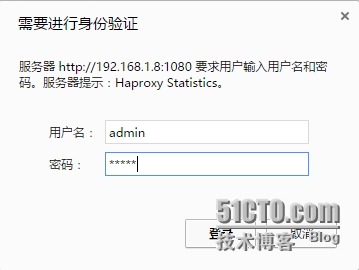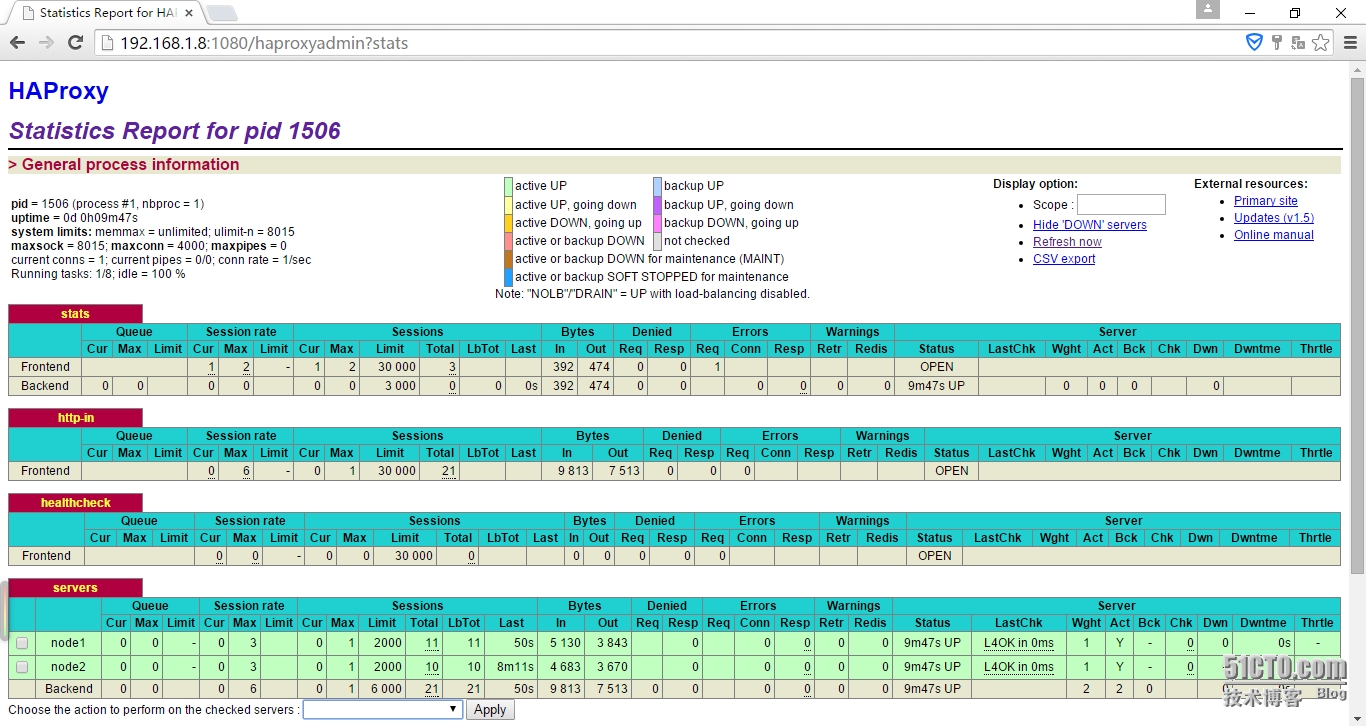一、准备反向代理环境
1、环境介绍
2、同步时间
[root@proxy ~]# ntpdate 202.120.2.101 [root@node1 ~]# ntpdate 202.120.2.101 [root@node2 ~]# ntpdate 202.120.2.101
3、node1、node2节点安装启动httpd并提供测试页
[root@node1 ~]# rpm -q httpd httpd-2.2.15-45.el6.centos.x86_64 [root@node1 ~]# cat /www/a.com/htdoc/index.html <h1>This is node1 !</h1> [root@node1 ~]# service httpd start 正在启动 httpd: [确定] [root@node2 ~]# rpm -q httpd httpd-2.2.15-45.el6.centos.x86_64 [root@node2 ~]# cat /www/a.com/htdoc/index.html <h1>This is node2 !</h1> [root@node2 ~]# service httpd start 正在启动 httpd: [确定]
4、测试各节点是否正常启动
[root@proxy ~]# curl http://192.168.1.9 <h1>This is node1 !</h1> [root@proxy ~]# curl http://192.168.1.10 <h1>This is node2 !</h1>
5、安装haproxy
[root@proxy ~]# rpm -q haproxy haproxy-1.5.4-2.el6_7.1.x86_64 [root@proxy ~]# rpm -ql haproxy /etc/haproxy /etc/haproxy/haproxy.cfg /etc/logrotate.d/haproxy /etc/rc.d/init.d/haproxy /etc/sysconfig/haproxy /usr/bin/halog /usr/bin/iprange /usr/sbin/haproxy
6、haproxy常用选项
语法:
haproxy [-f < 配置文件>] [ -vdVD ] [-n 最大并发连接总数] [-N 每个侦听的最大并发数] [ -p <当前的PID文件> ] [-m <内存限制M>]
-v 显示当前版本信息;-vv 显示已知的创建选项
-d 前台,debug模式;-db 禁用后台模式,程序跑在前台
-V 详细模式
-D daemon模式启动
-q 安静模式,不输出信息
-c 对配置文件进行语法检查
-n 最大并发连接总数
-m 限制的可用内存大小
-N 设置默认的连接数
-p 设置当前的PID文件
-de 不使用epoll
-ds 不使用speculative epoll
-dp 不使用poll
-sf 程序启动后向pidlist里的进程发送FINISH信号,这个参数放在命令行的最后
-st 程序启动后向pidlist里的进程发送TERMINATE信号,这个参数放在命令行的最后
7、查看rpm包提供的配置文件
[root@proxy ~]# cat /etc/haproxy/haproxy.cfg
#---------------------------------------------------------------------
# Example configuration for a possible web application. See the
# full configuration options online.
#
# http://haproxy.1wt.eu/download/1.4/doc/configuration.txt
#
#---------------------------------------------------------------------
#---------------------------------------------------------------------
# Global settings #全局配置文件
#---------------------------------------------------------------------
global
# to have these messages end up in /var/log/haproxy.log you will
# need to: #配置日志
#
# 1) configure syslog to accept network log events. This is done
# by adding the '-r' option to the SYSLOGD_OPTIONS in
# /etc/sysconfig/syslog #修改syslog配置文件
#
# 2) configure local2 events to go to the /var/log/haproxy.log
# file. A line like the following can be added to
# /etc/sysconfig/syslog #定义日志设备
#
# local2.* /var/log/haproxy.log
#
log 127.0.0.1 local2 #
#全局的日志配置 其中日志级别是[err warning info debug]
#local0 是日志设备,必须为如下24种标准syslog设备的一种:
#kern user mail daemon auth syslog lpr news
#uucp cron auth2 ftp ntp audit alert cron2
#local0 local1 local2 local3 local4 local5 local6 local7
chroot /var/lib/haproxy
pidfile /var/run/haproxy.pid #将所有进程的pid写入文件启动进程的用户必须有权限访问此文件。
maxconn 4000 #最大连接数,默认4000
user haproxy #用户
group haproxy #组
daemon ##创建1个进程进入deamon模式运行。此参数要求将运行模式设置为"daemon"
# turn on stats unix socket #unix socket 文件
stats socket /var/lib/haproxy/stats
#---------------------------------------------------------------------
# common defaults that all the 'listen' and 'backend' sections will
# use if not designated in their block #默认的全局设置,这些参数可以被利用配置到frontend,backend,listen组件
#---------------------------------------------------------------------
defaults
mode http #默认的模式mode { tcp|http|health },tcp是4层,http是7层,health只会返回OK
log global #采用全局定义的日志
option httplog #日志类别http日志格式
option dontlognull #不记录健康检查的日志信息
option http-server-close #每次请求完毕后主动关闭http通道
option forwardfor except 127.0.0.0/8 #不记录本机转发的日志
option redispatch #serverId对应的服务器挂掉后,强制定向到其他健康的服务器
retries 3 #3次连接失败就认为服务不可用,也可以通过后面设置
timeout http-request 10s #请求超时
timeout queue 1m #队列超时
timeout connect 10s #连接超时
timeout client 1m #客户端连接超时
timeout server 1m #服务器连接超时
timeout http-keep-alive 10s #长连接超时
timeout check 10s #检查超时
maxconn 3000 #最大连接数
#---------------------------------------------------------------------
# main frontend which proxys to the backends #frontend 与backends 代理配置
#---------------------------------------------------------------------
frontend main *:5000
#acl策略配置
acl url_static path_beg -i /static /p_w_picpaths /javascript /stylesheets
acl url_static path_end -i .jpg .gif .png .css .js
use_backend static if url_static #满足策略要求,则响应策略定义的backend页面
default_backend app #不满足则响应backend的默认页面
#---------------------------------------------------------------------
# static backend for serving up p_w_picpaths, stylesheets and such #定义使用静态后端图像,样式表等
#---------------------------------------------------------------------
backend static
balance roundrobin #负载均衡模式轮询
server static 127.0.0.1:4331 check #服务器定义
#---------------------------------------------------------------------
# round robin balancing between the various backends
#---------------------------------------------------------------------
backend app
balance roundrobin #负载均衡模式轮询
server app1 127.0.0.1:5001 check #服务器定义,check进行健康检查
server app2 127.0.0.1:5002 check
server app3 127.0.0.1:5003 check
server app4 127.0.0.1:5004 check
二、负载均衡Web服务器案例
1、更改配置文件
[root@proxy ~]# cp /etc/haproxy/haproxy.cfg{,.bak}
[root@proxy ~]# cat /etc/haproxy/haproxy.cfg
#---------------------------------------------------------------------
# Global settings
#---------------------------------------------------------------------
global
# to have these messages end up in /var/log/haproxy.log you will
# need to:
#
# 1) configure syslog to accept network log events. This is done
# by adding the '-r' option to the SYSLOGD_OPTIONS in
# /etc/sysconfig/syslog
#
# 2) configure local2 events to go to the /var/log/haproxy.log
# file. A line like the following can be added to
# /etc/sysconfig/syslog
#
# local2.* /var/log/haproxy.log
#
log 127.0.0.1 local2
chroot /var/lib/haproxy
pidfile /var/run/haproxy.pid
maxconn 4000
user haproxy
group haproxy
daemon
defaults
mode http
log global
option httplog
option dontlognull
option http-server-close
option forwardfor except 127.0.0.0/8
option redispatch
retries 3
timeout http-request 10s
timeout queue 1m
timeout connect 10s
timeout client 1m
timeout server 1m
timeout http-keep-alive 10s
timeout check 10s
maxconn 30000
listen stats
mode http
bind 0.0.0.0:1080
stats enable
stats hide-version
stats uri /haproxyadmin?stats
stats realm Haproxy\ Statistics
stats auth admin:admin
stats admin if TRUE
frontend http-in
bind *:80
mode http
log global
option httpclose
option logasap
option dontlognull
capture request header Host len 20
capture request header Referer len 60
default_backend servers
frontend healthcheck
bind :1099
mode http
option httpclose
option forwardfor
default_backend servers
backend servers
balance roundrobin
server node1 192.168.1.9:80 check maxconn 2000
server node2 192.168.1.10:80 check maxconn 2000
2、配置haproxy日志
[root@proxy ~]# vim /etc/sysconfig/rsyslog # Options for rsyslogd # Syslogd options are deprecated since rsyslog v3. # If you want to use them, switch to compatibility mode 2 by "-c 2" # See rsyslogd(8) for more details SYSLOGD_OPTIONS="-c 2 -r" [root@proxy ~]# vim /etc/rsyslog.conf #将下面四项取消注释 # Provides UDP syslog reception $ModLoad imudp $UDPServerRun 514 # Provides TCP syslog reception $ModLoad imtcp $InputTCPServerRun 514 #增加一行 local2.* /var/log/haproxy.log
重启日志服务:
[root@proxy ~]# service rsyslog restart
3、查检一下配置文件
[root@proxy ~]# haproxy -c -f /etc/haproxy/haproxy.cfg Configuration file is valid
4、启动haproxy
[root@proxy ~]# service haproxy start
5、查看服务端口
[root@proxy ~]# ss -tunlp |grep haproxy
udp UNCONN 0 0 *:49442 *:* users:(("haproxy",1506,5))
tcp LISTEN 0 128 *:1080 *:* users:(("haproxy",1506,4))
tcp LISTEN 0 128 *:1099 *:* users:(("haproxy",1506,7))
tcp LISTEN 0 128 *:80 *:* users
6、浏览器测试
7、配置文件说明
#---------------------------------------------------------------------
# Global settings 全局配置
#---------------------------------------------------------------------
global
# to have these messages end up in /var/log/haproxy.log you will
# need to:
#
# 1) configure syslog to accept network log events. This is done
# by adding the '-r' option to the SYSLOGD_OPTIONS in
# /etc/sysconfig/syslog
#
# 2) configure local2 events to go to the /var/log/haproxy.log
# file. A line like the following can be added to
# /etc/sysconfig/syslog
#
# local2.* /var/log/haproxy.log
#
#上面的注释是告诉我们怎么配置日志的
log 127.0.0.1 local2 #定义日志
chroot /var/lib/haproxy #安全模式
pidfile /var/run/haproxy.pid #pid文件
maxconn 4000 #最大连接数
user haproxy #用户
group haproxy #组合
daemon
#---------------------------------------------------------------------
# Proxy settings 代理配置,下面全是代理配置
#---------------------------------------------------------------------
defaults #配置默认参数的,这些参数可以被利用配置到frontend,backend,listen组件
mode http #默认的模式mode { tcp|http|health },tcp是4层,http是7层,health只会返回OK(注,health已经废弃)
log global #采用全局定义的日志
option httplog #日志类别http日志格式
option dontlognull #不记录健康检查的日志信息
option http-server-close #每次请求完毕后主动关闭http通道
option forwardfor except 127.0.0.0/8 #不记录本机转发的日志
option redispatch #serverId对应的服务器挂掉后,强制定向到其他健康的服务器
retries 3 #3次连接失败就认为服务不可用,也可以通过后面设置
timeout http-request 10s #请求超时
timeout queue 1m #队列超时
timeout connect 10s #连接超时
timeout client 1m #客户端连接超时
timeout server 1m #服务器连接超时
timeout http-keep-alive 10s #长连接超时
timeout check 10s #检查超时
maxconn 30000 #最大连接数
listen stats #listen是Frontend和Backend的组合体。这里定义的是haproxy监控!
mode http #模式http
bind 0.0.0.0:1080 #绑定的监控ip与端口
stats enable #启用监控
stats hide-version #隐藏haproxy版本
stats uri /haproxyadmin?stats #定义的uri
stats realm Haproxy\ Statistics #定义显示文字
stats auth admin:admin #认证
stats admin if TRUE
frontend http-in #接收请求的前端虚拟节点,Frontend可以根据规则直接指定具体使用后端的 backend(可动态选择)。这里定义的是http服务!
bind *:80 #绑定的监控ip与端口
mode http #模式http
log global #定义日志
option httpclose #每次请求完毕后主动关闭http通道
option logasap #
option dontlognull ##不记录健康检查的日志信息
capture request header Host len 20
capture request header Referer len 60
default_backend servers #定义的默认backend
frontend healthcheck
bind :1099
mode http
option httpclose
option forwardfor
default_backend servers #定义的默认backend
backend servers #后端服务集群的配置,是真实的服务器,一个Backend对应一个或者多个实体服务器。
balance roundrobin #负载均衡方式为轮询
server websrv1 192.168.18.201:80 check maxconn 2000 #定义server,check 健康检查,maxconn 定义最大连接数
server websrv2 192.168.18.202:80 check maxconn 2000
三、haproxy 监控功能详解
上面的配置文件已经配置使用的监控功能
1、浏览器访问一下 http://192.168.1.8:1080/haproxyadmin?stats
输入帐号密码,注意帐号及密码是在配置文件中定义的,
监控的web接口,注意此窗口能关闭后端的机器很危险,故密码设置一定要复杂。
2、模拟故障
[root@node1 ~]# service httpd stop
3、恢复故障
[root@node1 ~]# service httpd start
四、haproxy的配置举例
1、uri算法使用举例
修改配置文件:
backend servers balance uri server node1 192.168.1.9:80 check maxconn 2000 server node2 192.168.1.10:80 check maxconn 2000
提供测试文件:
[root@node1 htdoc]# for i in {1..10};do echo "<h1>node1.test$i</h1>" > test$i.html;done
[root@node1 htdoc]# cat test4.html
<h1>node1.test4</h1>
[root@node2 htdoc]# for i in {1..10};do echo "<h1>node2.test$i</h1>" > test$i.html;done
[root@node2 htdoc]# cat test6.html
<h1>node2.test6</h1>
从新载入配置文件:
浏览器测试:
2、前面我们已经基本配置了haproxy服务了,但是在算法上我使用的是轮询方法,下面就配置如何使用cookie会话保持。
修改配置文件:
backend servers balance roundrobin cookie node insert nocache server node1 192.168.1.9:80 check cookie node1 server node2 192.168.1.10:80 check cookie node2
从新载入配置文件:
浏览器测试:
3、让后端web服务器记录真实的访问客户端IP地址
更改后端web服务器的日志格式:
[root@node1 htdoc]# vim /etc/httpd/conf/httpd.conf
LogFormat "%{X-Forwarded-For}i %l %u %t \"%r\" %>s %b \"%{Referer}i\" \"%{User-Agent}i\"" combined
重新启动web服务器后进行测试访问后查看日志:
[root@node1 htdoc]# tail /var/log/httpd/access_log 192.168.1.103 - - [12/Sep/2015:21:13:03 +0800] "GET / HTTP/1.1" 200 42 "-" "Mozilla/5.0 (Windows NT 10.0; WOW64) AppleWebKit/537.36 (KHTML, like Gecko) Chrome/45.0.2454.85 Safari/537.36"
4、通过ACL实现网站访问的动静分离
我通过ACL将动态资源的访问到node1,而静态资源的访问定位到node2。先在node1安装php,实现php动态资源和httpd服务器的结合:
[root@node1 ~]# yum install -y php
创建测试页并将php服务启动:
[root@node1 ~]# cat /www/a.com/index.php <h1>This is node1 !</h1> <?php phpinfo(); ?>
修改配置文件:
[root@proxy ~]# cat /etc/haproxy/haproxy.cfg global # to have these messages end up in/var/log/haproxy.log you will #need to: # #1) configure syslog to accept network log events. This is done # by adding the '-r' option tothe SYSLOGD_OPTIONS in # /etc/sysconfig/syslog # #2) configure local2 events to go to the /var/log/haproxy.log # file. A line like thefollowing can be added to # /etc/sysconfig/syslog # # local2.* /var/log/haproxy.log # log 127.0.0.1 local2 chroot /var/lib/haproxy pidfile /var/run/haproxy.pid maxconn 4000 user haproxy group haproxy daemon #turn on stats unix socket stats socket /var/lib/haproxy/stats defaults mode http log global option httplog option dontlognull option http-server-close option forwardfor except 127.0.0.0/8 option redispatch retries 3 timeout http-request 10s timeout queue 1m timeout connect 10s timeout client 1m timeout server 1m timeout http-keep-alive 10s timeout check 10s maxconn 3000 listen stats bind :1080 mode http stats enable stats uri /haproxy?stats stats realm HAProxy\ Status stats auth admin:admin stats admin if TRUE frontend http-in bind *:80 mode http log global option httpclose option logasap option dontlognull capture request header Host len 20 capture request header Referer len 60 acl url_static path_beg -i /static /p_w_picpaths /javascript /stylesheets acl url_static path_end -i .html .jpg .jpeg .gif .png .css .js acl url_dynamic path_end -i .php .jsp use_backend static_servers if url_static use_backend dynamic_servers if url_dynamic default_backend dynamic_servers backend static_servers balance roundrobin server node2 192.168.1.10:80 check maxconn 1000 backend dynamic_servers balance roundrobin cookie srv insert nocache server node1 192.168.1.6:80 check maxconn 1000 cookie node1
从新载入haproxy配置文件并在浏览器中测试:
转载于:https://blog.51cto.com/cuchadanfan/1694860

































 262
262











 被折叠的 条评论
为什么被折叠?
被折叠的 条评论
为什么被折叠?








